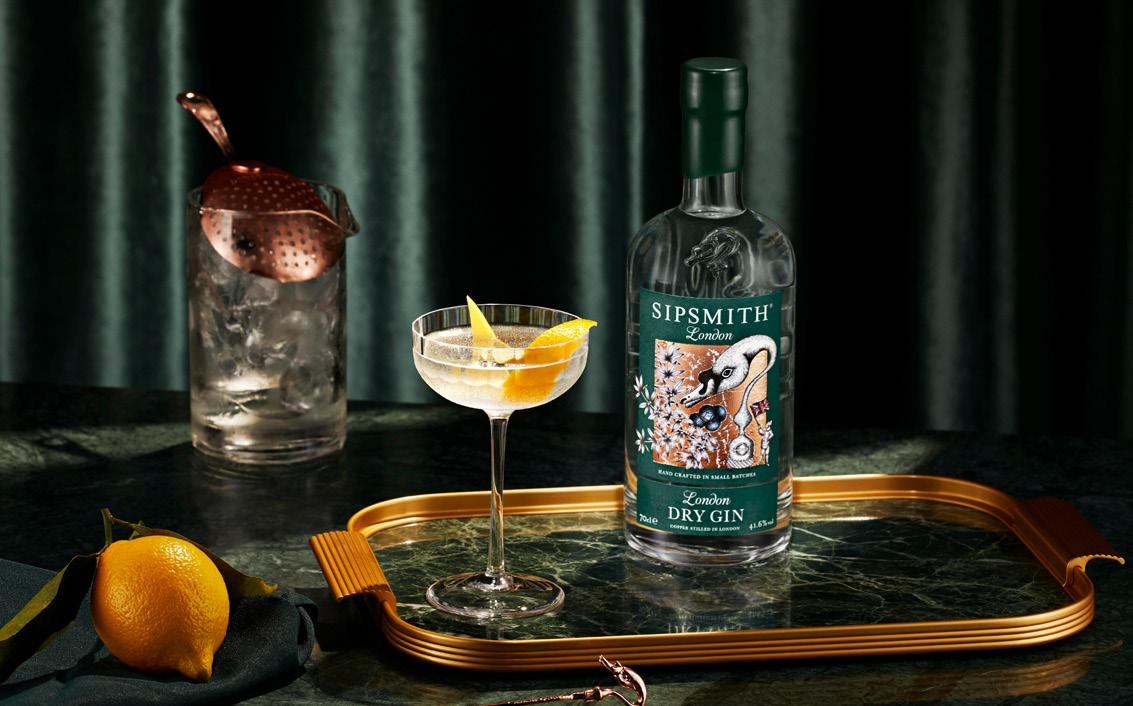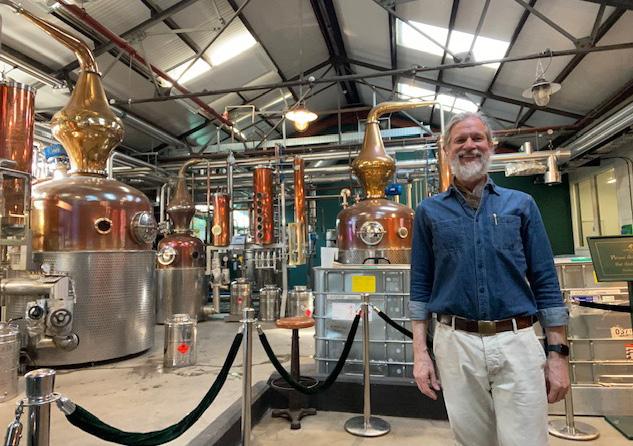
5 minute read
IN CONVERSATION
orange, lemon, lime and other citrus peels, and many others. Between that time and the start of Sipsmith we worked on a few other gins as well. However, we had to test the formula quite a few times on Prudence as distilling is not at all like cooking. Every still is different so a recipe must be tailored to a still. For example, when Constance our 1500-litre pot still arrived, it took eighteen 1500-litre batches with some of the botanicals varying as much as 25% in ratio to create identical gin on the larger still. Other great botanicals? There are so many. The gin we created for Raffles Hotel in Singapore uses Malay Basin botanicals in a classic London dry structure. Lemongrass, lime leaf, jasmine flower, mace, nutmeg, and others. I’m constantly exploring both traditional and less traditional gin botanicals. I grow Russian coriander in my garden, planted from Sipsmith coriander seeds. Last year I had around 100 plants. I grow liquorice, orris fiorentina, angelica, lemon verbena, lavender, artemisia alba, red and green shiso, sweet cicely, borage, lovage, marsh mallow, and loads of other plants. Good gin, like good wine, begins with fingers in the soil.
Q: Can you tell us why you chose to adopt the “one shot” method to make Sipsmith?
Advertisement
make gin as it used to be made, as it should be made. We may not take ourselves seriously but we take our gin very seriously. No compromises. If you’re developing a gin, make it the best you can. You are creating your own paradise or purgatory in the process, because at the end of the day—and frequently in the middle of the day—you’re going to have to taste it. And it had better be a liquid that will bring a smile to your face. Sipsmith definitely does that for me and the one-shot method is essential to that, delivering the botanicals as they should be and creating a distinctively rich mouthfeel.
Q: What cocktail according to you is the perfect expression of Sipsmith?
A: We constantly tested Sipsmith in the three most essential gin cocktails while developing it: the G&T, the martini and the negroni. So you could honestly say it was tailored for these. However, it is equally delicious in a fizz, a Collins, a white lady, a bees knees, an army-navy, a red snapper, a ramos. I’ve tested it in hundreds and hundreds of drinks and it has never let me down. (For further reading, check out SIP: 100 Gin Cocktails With Only Three Ingredients.)
small, so we worked to make it the best possible.
Q: What cocktail trends are you observing of late and how do they play to the strengths of a brand like Sipsmith?
A: Simplex drinks: Simple combinations of complex ingredients. A martini made with just gin and vermouth and a twist can contain the essences of dozens of botanicals. I’m seeing a lot of bars reaching further and finding fascinating ingredients but using fewer per drink. In the words of Antoine de St Exupery, author of The Little Prince, “perfection is achieved not when there is nothing more to add, but when there is nothing left to take away.”
Local modifiers and mixers and garnishes are on the rise as well, though one should never compromise quality for regionality when it comes to spirits.
Incidentally, the word ‘simplex’ appears in a 1753 medical book, The New Dispensatory. discovered it there last week while reading some of the phenomenal julep recipes in that book.
A: We have returned a few times to the Carl family who build our stills, and added Patience, Constance, Verity and Cygnet to our collection. Each is designed to make our gin exactly as we made our first batches. Each member of our distilling team is trained in how we handcraft gin, down to being able to confirm the beginning and the finish of the heart by the aroma. Over the years we have intentionally restricted our growth to ensure that we could maintain our quality every step of the way.
Q: What would be your advice to bartenders in India on the kind of cocktails that they should look at making using Sipsmith?
Q: What led to the brand being called Sipsmith?
A: A smith is a master craftsman. Fairfax’s father is a renowned silversmith. When he saw us taking an uncompromising approach to developing our gin, he remarked that we were doing what he does: we were applying traditional tools and skills learned from past masters to reveal the intrinsic beauty of the raw ingredients, to handcraft a masterpiece. He said, “You are smiths. Now you need to figure out what kind of smiths you are.”
To sip is to savour and enjoy, and that is how we became Sipsmith. (My mother’s maiden name was actually Smith, and her father and grandfather and great-grandfather were Smiths.
I have a side table in my house handcrafted by her father.)
Q: How many different individual distillates did you try before finalising the Sipsmith recipe? Are there any botanicals that you think have promise for any new variants?
A: We actually didn’t test that many botanicals when we started, in part because the three of us are traditionalists where gin is concerned (in my other work I am a historian of drink along with my wife). But also, in 1998 or 1999 Anistatia and I tested over 100 botanicals separately while helping to develop a gin in Boise, Idaho. It was at this time we did comparative studies of such ingredients as anise, star anise and liquorice root;
A: One-shot was how all good gin was made prior to sometime around 1870 when distilleries discovered they could make a gin concentrate and add a little to bottles of alcohol and water to turn them into bottles of gin—a method still used to produce the majority of the world’s volume of gin today because it is far more economical. For example Prudence, our first 300-litre still, could produce 9000-litre batches using the concentrate method. But she has only every produced 300-litre batches. Why? We
All that said, during the pandemic we made a Gibson (martini garnished with a cocktail onion) most nights. We only had one and it was rather
Q: Sipsmith is popularly believed to have sparked the craft gin trend in London, a spark that then fired the world over. How does a brand stay true to it’s craft credentials and values, even as it’s popularity, and one assumes therefore it’s production, increases.

A: it really depends on the bar. You are creating a guest experience, not just a drink. This, the drink must fit the experience. Your ultimate goal, in the words of the late great Gary Regan, is to make sure that people leave your bar feeling better than when they came in. Are your guests looking for martinistyle drinks? Are they leaning toward long and fruity drinks? Bitter flavours? Classics or new surprises? Everything from the drinks and menu to the furniture to your marketing should be done by putting yourself into your guests’ minds.
If I were stepping behind a bar there right now, I would reach back into the history of drink in India for my inspiration—drawn both from newspaper archives and from old texts. But that is because am a historian.
Most importantly, make every drink to the best of your ability. Get or make the best ice you can. Find the best glassware for your drinks. Use fresh-cut garnishes. Use the best mixers you can find. Leave no detail to chance. This doesn’t have to cost more, but it will always earn you more than if you don’t do this.










